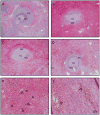Turf wars: exploring splenomegaly in sickle cell disease in malaria-endemic regions
- PMID: 28493472
- PMCID: PMC5494998
- DOI: 10.1111/bjh.14592
Turf wars: exploring splenomegaly in sickle cell disease in malaria-endemic regions
Abstract
Sickle cell disease (SCD) is a group of recessively inherited disorders of erythrocyte function that presents an ongoing threat to reducing childhood and adult morbidity and mortality around the world. While decades of research have led to improved survival for SCD patients in wealthy countries, survival remains dismal in low- and middle-income countries. Much of the early mortality associated with SCD is attributed to increased risk of infections due to early loss of splenic function. In the West, bacterial infections with encapsulated organisms are a primary concern. In sub-Saharan Africa, where the majority of infants with SCD are born, the same is true. However malaria presents an additional threat to survival. The search for factors that define variability in sickle cell phenotypes should include environmental modifiers, such as malaria. Further exploration of this relationship could lead to novel strategies to reduce morbidity and mortality attributable to infections. In this review, we explore the interactions between SCD, malaria and the spleen to better understand how splenomegaly and splenic (dys)function may co-exist in patients with SCD living in malaria-endemic areas.
Keywords: immune function; malaria; marginal zone B cell; sickle cell disease; spleen.
© 2017 John Wiley & Sons Ltd.
Conflict of interest statement
The authors have no relevant conflicts of interest to disclose.
Figures


Similar articles
-
The spectrum of splenic complications in patients with sickle cell disease in Africa: a systematic review.Br J Haematol. 2021 Apr;193(1):26-42. doi: 10.1111/bjh.17179. Epub 2020 Nov 7. Br J Haematol. 2021. PMID: 33161568
-
Epidemiology and treatment of relative anemia in children with sickle cell disease in sub-Saharan Africa.Expert Rev Hematol. 2016 Nov;9(11):1031-1042. doi: 10.1080/17474086.2016.1240612. Epub 2016 Oct 17. Expert Rev Hematol. 2016. PMID: 27677923 Review.
-
Malaria Infection in Patients with Sickle Cell Disease in Nigeria: Association with Markers of Hyposplenism.Hemoglobin. 2024 Jan;48(1):15-23. doi: 10.1080/03630269.2023.2285881. Epub 2024 Jan 22. Hemoglobin. 2024. PMID: 38247354
-
Hydroxyurea for children with sickle cell disease in sub-Saharan Africa: A summary of the evidence, opportunities, and challenges.Pharmacotherapy. 2023 May;43(5):430-441. doi: 10.1002/phar.2792. Epub 2023 Mar 26. Pharmacotherapy. 2023. PMID: 36906823 Review.
-
Malaria parasite density and splenic status by ultrasonography in stable sickle-cell anaemia (HbSS) children.Niger J Med. 2004 Jan-Mar;13(1):40-3. Niger J Med. 2004. PMID: 15296106
Cited by
-
Exploring the host factors affecting asymptomatic Plasmodium falciparum infection: insights from a rural Burkina Faso study.Malar J. 2023 Sep 1;22(1):252. doi: 10.1186/s12936-023-04686-0. Malar J. 2023. PMID: 37658365 Free PMC article.
-
Splenomegaly in Children and Adolescents.Front Pediatr. 2021 Jul 9;9:704635. doi: 10.3389/fped.2021.704635. eCollection 2021. Front Pediatr. 2021. PMID: 34307263 Free PMC article. Review.
-
Prevalence of Splenomegaly and Splenic Complications in Adults with Sickle Cell Disease and Its Relation to Fetal Hemoglobin.Int J Hematol Oncol Stem Cell Res. 2022 Oct 1;16(4):198-208. doi: 10.18502/ijhoscr.v16i4.10877. Int J Hematol Oncol Stem Cell Res. 2022. PMID: 36883109 Free PMC article.
-
Pediatric Sickle Cell Disease in Sudan: Complications and Management.Anemia. 2022 Feb 14;2022:3058012. doi: 10.1155/2022/3058012. eCollection 2022. Anemia. 2022. PMID: 35198244 Free PMC article.
-
Insights into determinants of spleen injury in sickle cell anemia.Blood Adv. 2019 Aug 13;3(15):2328-2336. doi: 10.1182/bloodadvances.2019000106. Blood Adv. 2019. PMID: 31391165 Free PMC article.
References
-
- Achtman AH, Khan M, MacLennan IC, Langhorne J. Plasmodium chabaudi chabaudi infection in mice induces strong B cell responses and striking but temporary changes in splenic cell distribution. J Immunol. 2003;171(1):317–324. - PubMed
-
- Adekile A, Adedodu O, Jeje A, Odesanmi W. Persistent gross splenomegaly in Nigeiran patients with sickle cell anaemia: relationship to malaria. Ann Trop Paediatr. 1988;8:103–107. - PubMed
-
- Adekile AD, McKie KM, Adeodu OO, Sulzer AJ, Liu JS, McKie VC, Kutlar F, Ramachandran M, Kaine W, Akenzua GI, Okolo AA, Obinyan EA, Ogala WN, Ibrahim M, Huisman THJl. Spleen in sickle cell anemia: comparative studies of Nigerian and U.S. patients. Am J Hematol. 1993;42(3):316–321. - PubMed
-
- Akinyanju OO, Otaigbe AI, Ibidapo MO. Outcome of holistic care in Nigerian patients with sickle cell anaemia. Clin Lab Haematol. 2005;27(3):195–199. - PubMed
Publication types
MeSH terms
Grants and funding
LinkOut - more resources
Full Text Sources
Other Literature Sources
Medical

